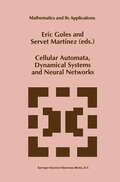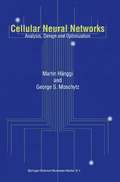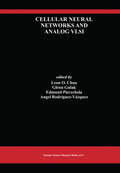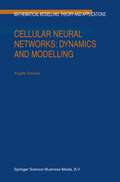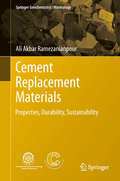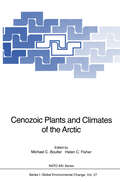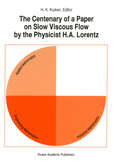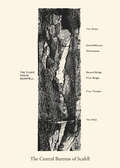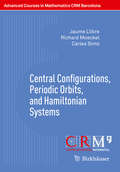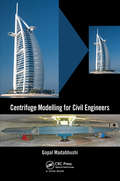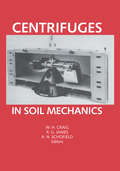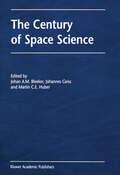- Table View
- List View
Cellular Automata, Dynamical Systems and Neural Networks (Mathematics and Its Applications #282)
by E. Goles Servet MartínezThis book contains the courses given at the Third School on Statistical Physics and Cooperative Systems held at Santiago, Chile, from 14th to 18th December 1992. The main idea of this periodic school was to bring together scientists work with recent trends in Statistical Physics. More precisely ing on subjects related related with non linear phenomena, dynamical systems, ergodic theory, cellular au tomata, symbolic dynamics, large deviation theory and neural networks. Scientists working in these subjects come from several areas: mathematics, biology, physics, computer science, electrical engineering and artificial intelligence. Recently, a very important cross-fertilization has taken place with regard to the aforesaid scientific and technological disciplines, so as to give a new approach to the research whose common core remains in statistical physics. Each contribution is devoted to one or more of the previous subjects. In most cases they are structured as surveys, presenting at the same time an original point of view about the topic and showing mostly new results. The expository text of Fran
Cellular Neural Networks: Analysis, Design and Optimization
by Martin Hänggi George S. MoschytzCellular Neural Networks (CNNs) constitute a class of nonlinear, recurrent and locally coupled arrays of identical dynamical cells that operate in parallel. ANALOG chips are being developed for use in applications where sophisticated signal processing at low power consumption is required. Signal processing via CNNs only becomes efficient if the network is implemented in analog hardware. In view of the physical limitations that analog implementations entail, robust operation of a CNN chip with respect to parameter variations has to be insured. By far not all mathematically possible CNN tasks can be carried out reliably on an analog chip; some of them are inherently too sensitive. This book defines a robustness measure to quantify the degree of robustness and proposes an exact and direct analytical design method for the synthesis of optimally robust network parameters. The method is based on a design centering technique which is generally applicable where linear constraints have to be satisfied in an optimum way. Processing speed is always crucial when discussing signal-processing devices. In the case of the CNN, it is shown that the setting time can be specified in closed analytical expressions, which permits, on the one hand, parameter optimization with respect to speed and, on the other hand, efficient numerical integration of CNNs. Interdependence between robustness and speed issues are also addressed. Another goal pursued is the unification of the theory of continuous-time and discrete-time systems. By means of a delta-operator approach, it is proven that the same network parameters can be used for both of these classes, even if their nonlinear output functions differ. More complex CNN optimization problems that cannot be solved analytically necessitate resorting to numerical methods. Among these, stochastic optimization techniques such as genetic algorithms prove their usefulness, for example in image classification problems. Since the inception of the CNN, the problem of finding the network parameters for a desired task has been regarded as a learning or training problem, and computationally expensive methods derived from standard neural networks have been applied. Furthermore, numerous useful parameter sets have been derived by intuition. In this book, a direct and exact analytical design method for the network parameters is presented. The approach yields solutions which are optimum with respect to robustness, an aspect which is crucial for successful implementation of the analog CNN hardware that has often been neglected. `This beautifully rounded work provides many interesting and useful results, for both CNN theorists and circuit designers.' Leon O. Chua
Cellular Neural Networks and Analog VLSI
by Leon Chua Glenn Gulak Edmund Pierzchala Ángel Rodríguez-VázquezCellular Neural Networks and Analog VLSI brings together in one place important contributions and up-to-date research results in this fast moving area. Cellular Neural Networks and Analog VLSI serves as an excellent reference, providing insight into some of the most challenging research issues in the field.
Cellular Neural Networks: Dynamics and Modelling (Mathematical Modelling: Theory and Applications #16)
by A. SlavovaConventional digital computation methods have run into a se rious speed bottleneck due to their serial nature. To overcome this problem, a new computation model, called Neural Networks, has been proposed, which is based on some aspects of neurobiology and adapted to integrated circuits. The increased availability of com puting power has not only made many new applications possible but has also created the desire to perform cognitive tasks which are easily carried out by the human brain. It become obvious that new types of algorithms and/or circuits were necessary to cope with such tasks. Inspiration has been sought from the functioning of the hu man brain, which led to the artificial neural network approach. One way of looking at neural networks is to consider them to be arrays of nonlinear dynamical systems that interact with each other. This book deals with one class of locally coupled neural net works, called Cellular Neural Networks (CNNs). CNNs were intro duced in 1988 by L. O. Chua and L. Yang [27,28] as a novel class of information processing systems, which posseses some of the key fea tures of neural networks (NNs) and which has important potential applications in such areas as image processing and pattern reco gnition. Unfortunately, the highly interdisciplinary nature of the research in CNNs makes it very difficult for a newcomer to enter this important and fasciriating area of modern science.
Celtic Geographies: Old Cultures, New Times (Critical Geographies Ser.)
by David C. Harvey Rhys Jones Neil McInroy Christine MilliganCeltic Geographies questions traditional conceptualizations of Celticity that rely on an homogenous interpretation of what it means to be a Celt in contemporary society. The various contributors break away from these traditional interpretations to critically explore a Celticity that is diverse in character. The book explores a number of themes that are central to historical and contemporary Celticity:* the historical geographies of Celtic peoples* devolution and politics in Celtic regions, such as Wales and Scotland* the commodification of Celticity in the tourism practices of Brittany and Ireland* the role of diaspora in the development of Celtic identities, in both North America and in the west of Scotland* the relationship between Celticity and forms of contemporary culture.
Celtic Geographies: Old Cultures, New Times
by David C. Harvey Rhys Jones Neil McInroy Christine MilliganCeltic Geographies questions traditional conceptualizations of Celticity that rely on an homogenous interpretation of what it means to be a Celt in contemporary society. The various contributors break away from these traditional interpretations to critically explore a Celticity that is diverse in character. The book explores a number of themes that are central to historical and contemporary Celticity:* the historical geographies of Celtic peoples* devolution and politics in Celtic regions, such as Wales and Scotland* the commodification of Celticity in the tourism practices of Brittany and Ireland* the role of diaspora in the development of Celtic identities, in both North America and in the west of Scotland* the relationship between Celticity and forms of contemporary culture.
Cement Replacement Materials: Properties, Durability, Sustainability (Springer Geochemistry/Mineralogy)
by Ali Akbar RamezanianpourThe aim of this book is to present the latest findings in the properties and application of Supplementary Cementing Materials and blended cements currently used in the world in concrete. Sustainability is an important issue all over the world. Carbon dioxide emission has been a serious problem in the world due to the greenhouse effect. Today many countries agreed to reduce the emission of CO2. Many phases of cement and concrete technology can affect sustainability. Cement and concrete industry is responsible for the production of 7% carbon dioxide of the total world CO2 emission. The use of supplementary cementing materials (SCM), design of concrete mixtures with optimum content of cement and enhancement of concrete durability are the main issues towards sustainability in concrete industry.
CENAS: Coastline Evolution of the Upper Adriatic Sea due to Sea Level Rise and Natural and Anthropogenic Land Subsidence (Water Science and Technology Library #28)
by GiuseppeGambolatiThe Upper Adriatic Sea basin comprises a very precarious coastal environment subject to continuous changes which prove appreciable not only over the geological scale but also in historical and modern times. According to some Authors the Venice Lagoon was formed 2000-3000 years ago, and other lagoons (e. g. the Grado Lagoon in the northernmost part of the Adriatic) are even more recent. In addition to lagoons, the Upper Adriatic coastal area includes salt and fresh-water marshes and reclaimed land separated by several watercourses originating from the Alpine and Apennine ranges with a ground elevation not exceeding in many places 2 m above the mean sea l. evel (msl). A significant fraction of this lowland is already now below msl because of natural and anthropogenic land subsidence, land reclamation and sea level rise occurred over the last century. Natural land subsidence is still under way as a result of deep downward tec tonic movement and consolidation of soils deposited in the most recent time. An thropogenic subsidence is primarily due to groundwater pumping for agricultural, industrial, civil, and tourist use, and to gas withdrawal from a large number of gas fields scattered through the Upper Adriatic basin, and may still continue, al though at a reduced rate, in the years to come. At the same time msl is expected to rise in the next century due to global climate change, mainly because of the greenhouse effect.
Cenozoic Plants and Climates of the Arctic (Nato ASI Subseries I: #27)
by Michael C. Boulter Helen FisherFifty million years ago, the Arctic Ocean was a warm sea, bounded by lush vegetation of the warm-temperate shores of Scandinavia, Siberia, Alaska and the Northwest Territories. Wind and storms were rare because Atlantic weather systems had not developed but, as today, polar day length added a hostile element to this otherwise tranquil climate.With the aid of scientists from all the countries close to the Arctic Circle, this book describes the palaeontology, the statistical analysis of vegetational features, comparisons with atmospheric, marine, and geological features and some of the first models of plant migration developed from newly constructed databases.
Cenozoic Volcanism in the Tyrrhenian Sea Region (Advances in Volcanology)
by Angelo PeccerilloThis is an updated edition of the book by the same author: "Plio-Quaternary volcanism in Italy - Petrology, geochemistry, geodynamics," published in 2005 by Springer. This edition has the same structure as the previous publication, with a general introduction; various chapters dedicated to different volcanic provinces in Italy; and a final chapter on the relationships between magmatism and geodynamics. It includes information that has become available in the last ten years, and new chapters have been added offering detailed discussions of the Oligo-Miocene orogenic volcanism on Sardinia and of some small outcrops of fragmented volcanic rocks occurring in several places of the Apennines. This new edition now covers the entire Tyrrhenian Sea magmatism of the last 40 Ma. Lastly, it includes two appendices: Appendix 1 reports on a comparison between the Tyrrhenian Sea volcanism and the partially coeval magmatism along the Alps and adjoining areas and has the objective of highlighting similarities and difference that can tell us much on geodynamics and magmatism between the converging plates of Europe and Africa. Appendix 2 is an update of the 2005 edition appendix and deals with classification of orogenic rocks with special emphasis on potassic alkaline volcanics.
The Centenary of a Paper on Slow Viscous Flow by the Physicist H.A. Lorentz
by H. K. KuikenThis book commemorates the appearance one hundred years ago of a paper on slow viscous flow, written by the physicist and Nobel laureate H.A. Lorentz. Although Lorentz is not remembered by most as a fluid dynamicist - indeed, his fame rests primarily on his contributions to the theory of electrons, electrodynamics and early developments in relativity - his fluid-mechanics paper of 1896 contains many ideas which have remained important in fluid mechanics to this very day. In that short paper he put forward his reciprocal theorem (an integral-equation formulation which is used extensively nowadays in boundary-element calculations) and his reflection theorem. Furthermore, he must be credited with the invention of the stokeslet. The contributors to this book have all made their mark in slow viscous flow. Each of these authors highlights further developments of one of Lorentz's ideas. There are applications in sintering, micropolar fluids, bubbles, locomotion of microorganisms, non-Newtonian fluids, drag calculations, etc. Other contributions are of a more theoretical nature, such as the flow due to an array of stokeslets, the interaction between a drop and a particle, the interaction of a particle and a vortex, the reflection theorem for other geometries, a disk moving along a wall and a higher-order investigation. Lorentz's paper of 1896 is also included in an English translation. An introductory paper puts Lorentz's work in fluid mechanics in a wider perspective. His other great venture in fluid mechanics - his theoretical modelling on the enclosure of the Zuyderzee - is also discussed. The introduction also presents a short description of Lorentz's life and times. It was Albert Einstein who said of Lorentz that he was `...the greatest and noblest man of our time'.
A Centennial History of the Ecological Society of America
by Frank N. EgertonCelebrating its 100th anniversary in 2015, the Ecological Society of America (ESA) is the largest professional society devoted to the science of ecology. A Centennial History of the Ecological Society of America tells the story of ESA's humble beginnings, growing from approximately 100 founding members and a modest publication of a few pages to a m
The Central Amazon Floodplain: Ecology of a Pulsing System (Ecological Studies #126)
by Wolfgang J. JunkFloodplains are ecosystems which are driven by periodic inundation and oscillation between terrestrial and aquatic phases. An understanding of such pulsing systems is only possible by studying both phases and linking the results into an integrated overview.This book presents the results of a 15-year study of the structure and function of one of the largest tropical floodplains, the Amazon River floodplain. It covers qualitative aspects, e.g., adaptations of aquatic and terrestrial organisms to the flood pulse as well as quantitative aspects, e.g., studies of biomass, primary production, decomposition, and nutrient cycles. The authors interpret their findings and the most important data from other studies under an integrating scientific concept, the Flood Pulse Concept.
Central American Biodiversity: Conservation, Ecology, and a Sustainable Future
by Falk HuettmannThis book highlights key results and lessons learnt from two field sites, La Suerte in Costa Rica and Ometepe Nicaragua. It provides long term data on species abundance and distribution. Primates receive specific attention in this book, as they are flagship species and good indicators for the “health” of an ecosystem, but as well a money maker. Many primate species are sensitive to habitat alteration, and are often hunted out first. But they play an important role as seed dispersal agents for the regeneration of the forest. The book then compares results from the two field sites with regional trends, and explores potential solutions such as REDD+. This book strongly calls for new approaches in conservation, it makes the case for looking beyond the pure species biology and classic conservation angle and to take into account the economic and political realities.
Central Asia and the Silk Road: Economic Rise and Decline over Several Millennia (Studies in Economic History)
by Stephan BarisitzThis book offers a comprehensive overview of the pre-modern economic history of Central Asia and the Silk Road, covering several millennia. By analyzing an abundance of sources and materials, it illustrates the repeated economic heydays of the Silk Road, during which it linked the Orient and Occident for many centuries. Nomadic steppe empires frequently dominated Central Asia, molded its economy and influenced trade along the Silk Road. The book assesses the causes and effects of the wide-ranging overland trade booms, while also discussing various internal and external factors that led to the gradual economic decline of Central Asia and eventual demise of the Silk Road. Lastly, it explains how the economic decline gave rise to Chinese and Russian colonialism in the 18th and 19th centuries. Detailed information, e.g. on the Silk Road’s trajectories in various epochs, is offered in the form of numerous newly drafted maps.
Central Banking, Monetary Policy and the Environment (The Elgar Series on Central Banking and Monetary Policy)
Part of the Elgar Series on Central Banking and Monetary Policy, this book explores the relationship between central banking, monetary policy and the economy at large. It focuses on the specific relationship between central banking, monetary policy and the environment as central banks wake up to new realities.The book examines not only the impact of changes in interest rates on the environment, but also the impact that the environment and climate change have on monetary policy. New green policies are proposed for central banks to implement as they move forward and navigate the pitfalls of climate change.Scholars and students interested in central banking, monetary policy and the environment will appreciate this take on Central Banking, Monetary Policy and the Environment.
The Central Buttress of Scafell: A collection of essays selected and introduced by Graham Wilson
by Graham WilsonFew climbs are awarded the honour of being reduced to their initials. CB, the Central Buttress of Scafell, considered for years to be the hardest climb in the British Isles, is one of them. 'Have any of you ever noticed a bayonet-shaped crack descending from the skyline about midway between Moss Ghyll and Botterill's Crack on Scawfell? No? Has it never occurred to you that between these two climbs there is a stretch of nearly two hundred feet of unscaled rock? No?'- Ashley P Abraham, 1907. Despite this attempt by the president of the Fell & Rock Climbing Club to goad the younger generation into action, it was another seven years before Siegfried Herford made the first ascent of Central Buttress. Ten historic essays, reproduced by courtesy of the FRCC and the Yorkshire Ramblers' Club, chart the stages by which this legendary route was besieged, conquered and finally, apparently, domesticated. Or was it? In his introduction and commentary, Graham Wilson assesses the growth of the myth, the challenges of the climb and its status one hundred years on. And, as a coda, a twenty-first-century account by a young female climber reflects on the achievements of those who went before.
Central Configurations, Periodic Orbits, and Hamiltonian Systems (Advanced Courses in Mathematics - CRM Barcelona)
by Jaume Llibre Richard Moeckel Carles SimóThe notes of this book originate from three series of lectures given at the Centre de Recerca Matemàtica (CRM) in Barcelona. The first one is dedicated to the study of periodic solutions of autonomous differential systems in Rn via the Averaging Theory and was delivered by Jaume Llibre. The second one, given by Richard Moeckel, focusses on methods for studying Central Configurations. The last one, by Carles Simó, describes the main mechanisms leading to a fairly global description of the dynamics in conservative systems.The book is directed towards graduate students and researchers interested in dynamical systems, in particular in the conservative case, and aims at facilitating the understanding of dynamics of specific models. The results presented and the tools introduced in this book include a large range of applications.
The Centre of City: Thermal Environment and Spatial Morphology
by Junyan Yang Xing ShiA major objective of this monograph is to identify the impact of thermal environment on urban center district. It provides in-depth evaluation and research on the correlation between urban spatial morphology indicator and urban thermal environment. In addition, the distribution characteristics of thermal environment and urban morphology units sample are also evaluated intensively. Furthermore, it analyses from three aspects of urban planning, architecture and landscape respectively and includes 35 concrete measures that could be brought into practice on reducing negative impact of urban thermal environment. Through 500 vivid figures, graphs and diagrams it illustrates the relationship between urban morphology and urban thermal environment. The analysis software employed by the author includes Ecotect, ENVI-met and Ray-man. It intertwines the quantitative research of both thermal environment and urban morphology through in-depth analysis and urban microclimate simulation. It makes a valuable contribution for the research on urban environment and urban morphology.
Centrifuge Modelling for Civil Engineers
by Gopal MadabhushiSolve Complex Ground and Foundation Problems Presenting more than 25 years of teaching and working experience in a wide variety of centrifuge testing, the author of Centrifuge Modelling for Civil Engineers fills a need for information about this field. This text covers all aspects of centrifuge modelling. Expertly explaining the basic principles, the book makes this technique accessible to practicing engineers and researchers. Appeals to Non-Specialists and Specialists Alike Civil engineers that are new to the industry can refer to this material to solve complex geotechnical problems. The book outlines a generalized design process employed for civil engineering projects. It begins with the basics, and then moves on to increasingly complex methods and applications including shallow foundations, retaining walls, pile foundations, tunnelling beneath existing pile foundations, and assessing the stability of buildings and their foundations following earthquake-induced soil liquefaction. It addresses the use of modern imaging technique, data acquisition, and modelling techniques. It explains the necessary signal processing tools that are used to decipher centrifuge test data, and introduces the reader to the specialist aspects of dynamic centrifuge modelling used to study dynamic problems such as blast, wind, or wave loading with emphasis on earthquake engineering including soil liquefaction problems. Introduces the equipment and instrumentation used in centrifuge testing Presents in detail signal processing techniques such as smoothing and filtering Provides example centrifuge data that can be used for sample analysis and interpretation Centrifuge Modelling for Civil Engineers effectively describes the equipment, instrumentation, and signal processing techniques required to make the best use of the centrifuge modelling and test data. This text benefits graduate students, researchers, and practicing civil engineers involved with geotechnical issues.
Centrifuge Modelling for Civil Engineers
by Gopal MadabhushiSolve Complex Ground and Foundation Problems Presenting more than 25 years of teaching and working experience in a wide variety of centrifuge testing, the author of Centrifuge Modelling for Civil Engineers fills a need for information about this field. This text covers all aspects of centrifuge modelling. Expertly explaining the basic principles, the book makes this technique accessible to practicing engineers and researchers. Appeals to Non-Specialists and Specialists Alike Civil engineers that are new to the industry can refer to this material to solve complex geotechnical problems. The book outlines a generalized design process employed for civil engineering projects. It begins with the basics, and then moves on to increasingly complex methods and applications including shallow foundations, retaining walls, pile foundations, tunnelling beneath existing pile foundations, and assessing the stability of buildings and their foundations following earthquake-induced soil liquefaction. It addresses the use of modern imaging technique, data acquisition, and modelling techniques. It explains the necessary signal processing tools that are used to decipher centrifuge test data, and introduces the reader to the specialist aspects of dynamic centrifuge modelling used to study dynamic problems such as blast, wind, or wave loading with emphasis on earthquake engineering including soil liquefaction problems. Introduces the equipment and instrumentation used in centrifuge testing Presents in detail signal processing techniques such as smoothing and filtering Provides example centrifuge data that can be used for sample analysis and interpretation Centrifuge Modelling for Civil Engineers effectively describes the equipment, instrumentation, and signal processing techniques required to make the best use of the centrifuge modelling and test data. This text benefits graduate students, researchers, and practicing civil engineers involved with geotechnical issues.
Centrifuges in Soil Mechanics
by W. H. Craig R. G. James A. N. SchofieldThis book contains technical papers, presented in a discussion session at the XI International Conference on Soil Mechanics and Foundation Engineering held in San Francisco in 1985, on the role of centrifuge in geotechnical testing, with descriptions of test facilities.
Centrifuges in Soil Mechanics
by R.G.JAMES and A.N.SCHOFIELDThis book contains technical papers, presented in a discussion session at the XI International Conference on Soil Mechanics and Foundation Engineering held in San Francisco in 1985, on the role of centrifuge in geotechnical testing, with descriptions of test facilities.
The Century of Space Science
by J. A. Bleeker Johannes Geiss M. HuberOne of the most attractive features of the young discipline of Space Science is that many of the original pioneers and key players involved are still available to describe their field. Hence, at this point in history we are in a unique position to gain first-hand insight into the field and its development. To this end, The Century of Space Science, a scholarly, authoritative, reference book presents a chapter-by-chapter retrospective of space science as studied in the 20th century. The level is academic and focuses on key discoveries, how these were arrived at, their scientific consequences and how these discoveries advanced the thoughts of the key players involved. With over 90 world-class contributors, such as James Van Allen, Cornelis de Jager, Eugene Parker, Reimar Lüst, and Ernst Stuhlinger, and with a Foreword by Lodewijk Woltjer (past ESO Director General), this book will be immensely useful to readers in the fields of space science, astronomy, and the history of science. Both academic institutions and researchers will find that this major reference work makes an invaluable addition to their collection.
A Century of Weather Service: A History of the Birth and Growth of the National Weather Service, 1870-1970 (Routledge Revivals)
by Patrick HughesFirst Published in 1970, A Century of Weather Service provides a comprehensive history of the birth and growth of the National Weather Service from 1870 to 1970 in America. It discusses important themes such as coping with disaster; American weather pioneers; a military weather service; The United States Weather Bureau; the air commerce age; weather in war; growth of a global weather service; calculated weather risks; the air we breathe; and one world of weather. The book closes with a chronology of the meteorological milestones of the American weather services from 1644 to 1970.This is an important historical work for students of environmental geography and general readers interested in the topic.
